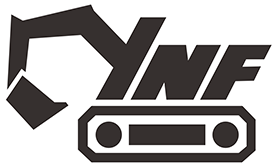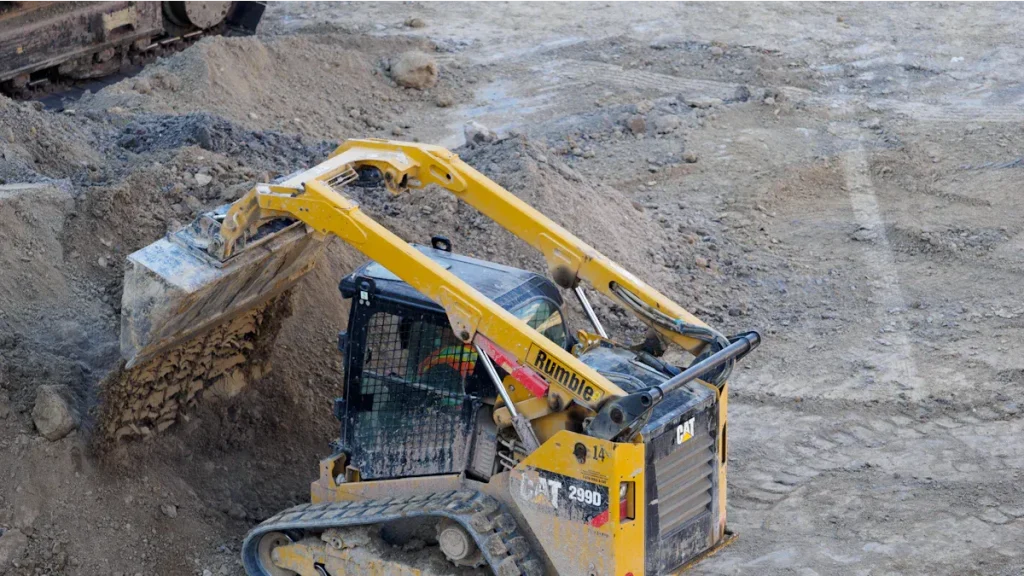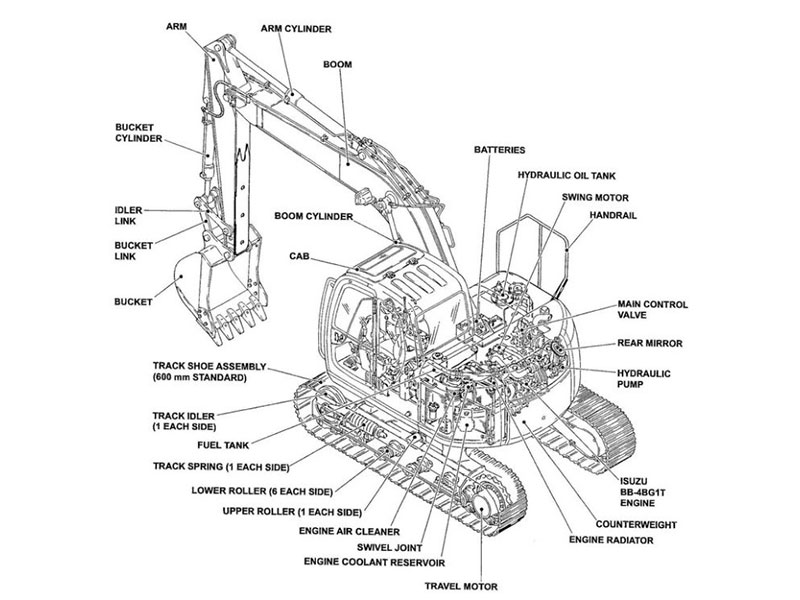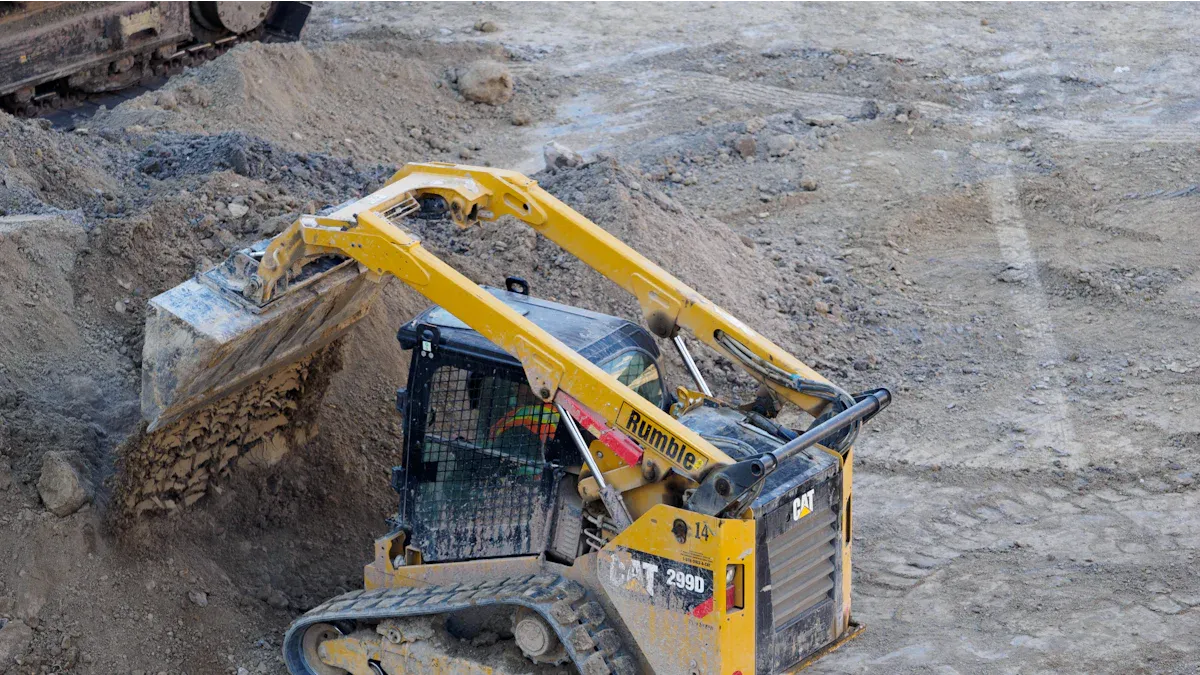
You count on the excavator track system to keep your machine steady and moving at any job site. This system spreads the excavator’s weight over the ground. This stops the machine from sinking and keeps it stable during hard digging jobs. The main parts are track chains, track shoes, rollers, idlers, sprockets, track adjusters, recoil springs, final drives, and rock guards. Each of these excavator track parts helps the machine grip the ground, take in shocks, and move easily. When you look at the basic parts of an excavator, you see how they all work together for movement, balance, and strength. Knowing the parts of an excavator helps you see how these parts protect your machine and keep it safe.
Key Takeaways
The excavator track system helps the machine stay steady. It lets the machine move over bumpy ground. It does this by spreading out its weight.
Important parts like track chains, shoes, rollers, idlers, sprockets, and rock guards work together. They help the machine grip the ground. They guide how the machine moves. They also protect the machine from damage.
You should check and take care of track tension, rollers, and other parts often. This stops them from wearing out too fast. It helps you avoid breakdowns. It also makes the excavator last longer.
Picking the right track shoes for your work site is important. It gives the machine better grip and makes it last longer. This helps the excavator work well on different types of ground.
Knowing how each track part works is helpful. It lets you find problems early. It keeps your machine safe. It also helps you save money on repairs.
Excavator Track System
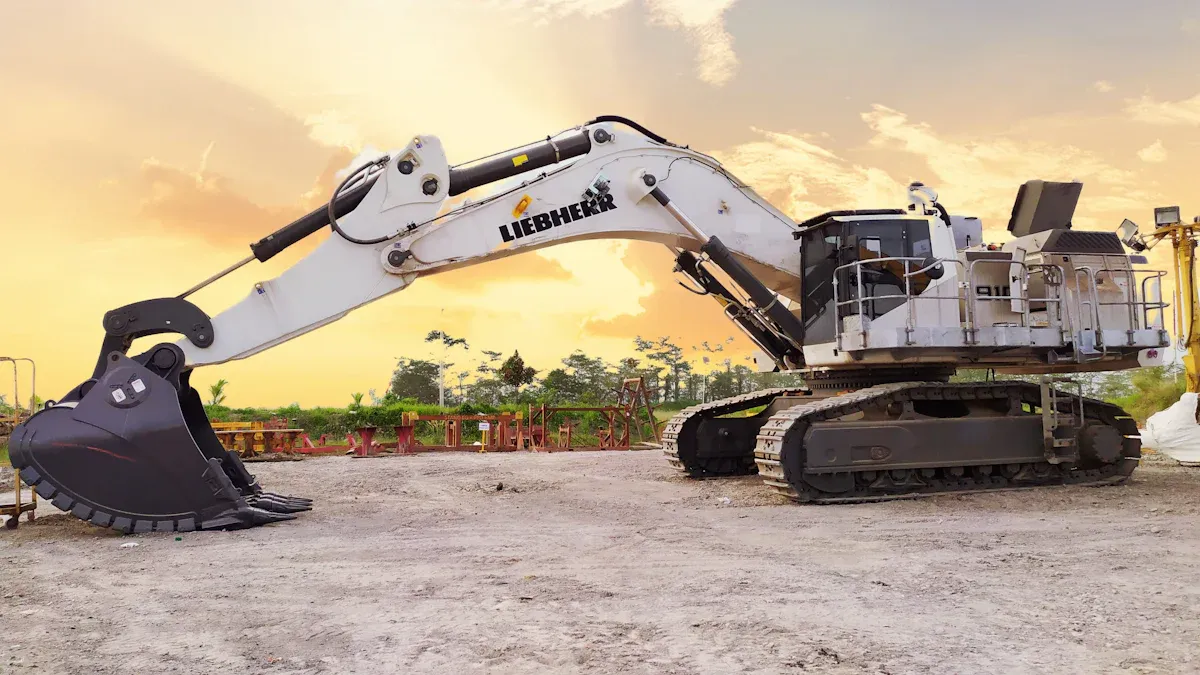
Main Components of an Excavator
You rely on the excavator track system to move your machine across rough ground. This system forms the foundation of the excavator undercarriage. It gives your machine the ability to travel, turn, and stay balanced on uneven surfaces. The undercarriage supports the weight of the excavator and spreads it out over the ground. This helps prevent the machine from sinking or tipping.
When you look at the main components of an excavator, you see how each part works together. Here are the basic parts of an excavator track system:
Excavator tracks – These steel-reinforced rubber tracks let your machine move over dirt, gravel, and mud.
Track frame – This strong structure holds the tracks in place and connects them to the excavator.
Track pads – These parts give traction and help reduce noise and vibration.
Track chains – These flexible links allow the tracks to bend and move smoothly.
Track shoes – These dig into the ground for extra grip.
Track bolts – These fasten the track shoes together.
Rock guards – These protect the undercarriage from rocks and debris.
Sprockets – These turn the track chains and move the excavator forward or backward.
Rollers – These metal wheels guide the tracks and keep them aligned.
Idlers – These large wheels help guide the tracks and keep them tight.
Tip: Knowing the track components helps you spot problems early and keep your excavator running longer.
Track Frame
The track frame is the backbone of the excavator undercarriage. You find it made from high-tensile steel, which gives it strength and durability. The frame supports the weight of the excavator and spreads it evenly across the tracks. This design helps your machine stay stable, even on soft or uneven ground. Engineers test the frame for strength and wear, so you can trust it to last through tough jobs. The track frame also keeps the track components in the right position, which reduces wear and helps the excavator work smoothly. When you take care of the track frame, you protect all the excavator track parts and make your machine last longer.
Excavator Track Parts

Track Chains
Track chains form the backbone of your excavator’s movement system. You see these as a series of steel links connected to create a flexible loop. The chains support the weight of your machine and help it move smoothly over rough ground. Each link in the chain works with the pads to provide traction and stability. The rollers and idlers guide the chains, spreading the weight and reducing friction. Sprockets grip the links and transfer power from the engine, moving the chains forward or backward. Keeping the right tension in your track chains prevents extra wear and keeps your excavator running longer.
Track chains and pads support the excavator’s weight and provide traction.
Rollers and idlers guide the chains, distribute weight, and reduce friction.
Sprockets engage with the links to move the excavator.
Proper tensioning prevents wear and ensures smooth operation.
The undercarriage, including sprockets, idlers, rollers, and drives, works together to move your machine over any terrain.
Tip: Check your track chains often for wear or slack. This helps you avoid breakdowns and keeps your excavator working hard.
Track Shoes (Track Pads)
Track shoes, also called track pads, attach to the chains and make direct contact with the ground. You rely on these pads for traction and stability. Most track shoes use grousers—raised ridges that dig into mud, gravel, or rock. This design prevents slipping and helps your excavator work in tough conditions. The pads spread the machine’s weight, lowering ground pressure and stopping it from sinking on soft surfaces. You find different types of track shoes for different jobs. Steel shoes last longer and grip better on rough ground, but they can damage hard surfaces. Rubber pads protect pavement but wear out faster.
Track shoes are usually made from high manganese alloy steel. This metal gets harder as it wears, making the pads last longer. The shape of the pad—single, double, or triple rib—changes how much grip and soil contact you get. Single rib shoes give more traction but are rare on excavators. The rib pattern also helps clean off mud, keeping traction strong. If your track tension is wrong, the pads wear out faster and lose grip.
Track Shoe Type | Description/Design Features | Suitable Ground Conditions | Key Advantages/Use Cases |
|---|---|---|---|
Single-tooth (Single-rib) | One rib for basic traction | Soft terrain (sand, snow) | Good grip on soft ground |
Double-tooth (Double-rib) | Two ribs for balance and durability | General earthworks | Cost-effective, handles moderate loads |
Three-tooth (Triple-rib) | Three ribs for strength and impact resistance | Hard terrain (rocks) | High load capacity, resists wear |
Flat-bottomed | Wide, smooth bottom for more ground contact | Soft or loose ground (sand, mud) | Reduces sinking, improves traction |
Swamp track shoe | Wide with special grooves for wet, soft ground | Swamps, wetlands | Prevents slipping, increases stability |
Special track shoe | Custom for harsh environments (high temp, corrosive) | Extreme conditions | Extended service life |
Note: Choosing the right track pad for your job site helps your excavator perform better and last longer.
Track Rollers (Bottom Rollers)
Track rollers, or bottom rollers, sit under the track frame and support the weight of your excavator. You depend on these rollers to spread the load evenly across the tracks. This even weight keeps your machine stable, especially on soft or uneven ground. The rollers also guide the tracks, reduce friction, and help the undercarriage last longer.
Track rollers distribute the excavator’s weight across the tracks.
They keep your machine stable and balanced.
Rollers guide the tracks and reduce friction for smoother movement.
You should inspect your track rollers every month. Look for wear, damage, or rollers that do not turn. Most rollers last about 2,000 to 2,500 hours with good care. Replace them if you see problems to avoid bigger repairs. Clean and lubricate the rollers often to keep your excavator running smoothly.
Carrier Rollers (Top Rollers)
Carrier rollers, or top rollers, sit above the track chains. You use these rollers to support the upper part of the track and keep it in place. Carrier rollers reduce the load on the front wheels and sprockets. This support helps the track chain stay in the right position and move smoothly, even in tough conditions. While bottom rollers carry the machine’s weight, carrier rollers hold up and guide the top of the track. This reduces wear on other parts and helps your undercarriage last longer.
Idlers
Idlers are large wheels at the front of your excavator’s undercarriage. You rely on idlers to guide the tracks and keep them tight. The idler works with the track adjuster to control tension. When you pump grease into the adjuster, the idler moves forward and tightens the track. If you release grease, the idler moves back and loosens the track. Proper idler alignment keeps the tracks straight and prevents extra wear. If the idler shifts, you can adjust it with shims. A well-aligned idler stops the track from whipping or swaying.
Watch for signs of idler trouble:
Excessive track slack or loose tracks
Grinding, clunking, or squealing noises
Uneven track wear or misalignment
Visible cracks, dents, or rust on the idler
Tip: Regularly check your idlers for damage or misalignment. This keeps your excavator running safely and smoothly.
Sprockets
Sprockets are toothed wheels at the back of your excavator’s undercarriage. You use sprockets to transfer power from the final drive to the track chain. The sprocket teeth fit into the links of the chain, turning it as the final drive rotates. This action moves your excavator forward or backward. The sprocket must grip the chain tightly to avoid slipping. Worn or damaged teeth reduce power and can cause the track to come off. Sprockets act as the last gear in the drive system, working with the internal gears to give your machine the right balance of speed and torque.
Track Adjusters
Track adjusters help you keep the right tension in your tracks. You find the adjuster behind the front idler. When you add grease with a grease gun, the adjuster pushes the idler forward and tightens the track. If you need to loosen the track, you release grease from the adjuster valve. Regularly check the valve for leaks to keep tension correct. Proper tension stops the track from slipping off and reduces wear on all excavator track parts.
Recoil Springs
Recoil springs work with the track adjuster to absorb shocks and keep the track tight. When your excavator hits a bump or the track meets resistance, the recoil spring compresses. This action protects the idler and track from damage. The spring also helps keep the track at the right tension, even when the ground is rough. If the recoil spring is weak or broken, your track may come loose or wear out faster. A good recoil spring extends the life of your undercarriage and keeps your excavator safe.
Final Drives
Final drives are powerful gearboxes that sit at the end of your excavator’s drive system. You use final drives to turn hydraulic power into mechanical movement. The hydraulic motor sends pressurized fluid to the final drive, which creates rotational force. Inside, a gear system increases torque and lowers speed, giving your excavator the strength to move heavy loads. The final drive sends this torque to the sprocket, which turns the track chain. Bearings inside the final drive keep everything turning smoothly. An internal brake helps you control movement and stop safely.
Hydraulic motors convert fluid power into rotation.
Gears increase torque for digging and moving.
The output shaft connects to the sprocket, moving the tracks.
Bearings and brakes ensure smooth, safe operation.
You should check the oil level and quality in your final drives often. Change oil and filters on schedule. Watch for leaks, noise, or overheating. Early repairs prevent bigger problems and keep your excavator working hard.
Rock Guards
Rock guards attach to your excavator’s tracks to protect them from rocks, debris, and stray objects. You use rock guards to shield the undercarriage and track components from damage on tough job sites. These guards help your equipment last longer by stopping rocks from hitting or jamming the tracks. They also lower maintenance costs and keep your excavator running reliably in harsh conditions.
Rock guards protect tracks from rocks and debris.
They prevent damage and reduce repair costs.
Guards help your excavator work better in rough environments.
Note: Adding rock guards is a smart way to protect your investment and keep your excavator in top shape.
How Excavator Tracks Work
Movement
Your excavator’s track system helps it move on rough ground. All the parts work together to turn engine power into movement. Sprockets grab the track chain and move it forward or backward. The sprocket’s segments help spread weight and stop fast wearing. Track pads touch the ground and help the excavator grip. Chains and shoes connect the pads, so the tracks can bend and move. Bolts keep all the pieces together. Rock guards block rocks and dirt from the moving parts. Track rollers and idlers guide the track and keep it tight.
Sprockets change engine power into movement.
Track pads and chains help the excavator grip and bend.
Rollers and idlers keep the track straight and moving well.
When these parts work together, your excavator can move over mud, rocks, or gravel without getting stuck.
Stability
Your excavator must stay steady when digging or lifting. The track system spreads the machine’s weight over a big area. This stops the excavator from sinking or tipping over. Always follow the weight limits from the manufacturer. Spread heavy loads so the undercarriage does not get too much stress.
Stay under weight limits to keep balance.
Spread heavy loads to stop tipping.
Follow the manufacturer’s rules for safe use.
Do regular maintenance.
Train workers to use the excavator safely.
These steps help you stop accidents and keep your excavator steady at any job site.
Durability
You want your excavator to last through hard jobs. The track system faces dirt, rocks, and heavy loads every day. Good materials make the parts last longer. Cheap parts wear out faster. Wet or sandy ground can cause rust or more wear. How you use the excavator also changes how long the tracks last. Fast turns, quick stops, and high speeds wear out parts faster.
Check track tension often.
Clean the undercarriage after muddy or icy work.
Oil moving parts to stop rust.
Change worn rollers or idlers to keep the track straight.
Do not overload the excavator.
Regular care keeps your tracks strong and your excavator working longer.
Knowing about each excavator track part helps you keep your machine safe. When you learn how track pads, chains, bolts, rock guards, sprockets, rollers, and idlers work, you can find problems early. This helps you stop breakdowns before they happen.
Check your excavator often and replace parts when needed. This stops big repairs and keeps your machine working well.
Look at your machine every day, clean it, and keep the tension right. These steps help your equipment last longer.
Use what you know to help your excavator work better and last longer on every job.
FAQ
How often should you check your excavator tracks?
You should inspect your tracks every day before you start work. Look for loose bolts, worn pads, or damaged rollers. Early checks help you catch problems before they get worse.
Tip: Clean mud and debris from the undercarriage after each use.
What causes excavator tracks to come off?
Loose track tension, worn sprockets, or damaged idlers can cause tracks to slip off. You should keep the tension correct and replace worn parts quickly. This keeps your machine safe and working well.
Can you use rubber tracks instead of steel tracks?
You can use rubber tracks for work on pavement or finished surfaces. Rubber tracks protect the ground and reduce noise. Steel tracks last longer on rough ground and give better grip in tough conditions.
How do you know when to replace track rollers?
Listen for grinding or squeaking noises. Check for flat spots or rollers that do not turn. If you see uneven wear or leaking oil, you should replace the rollers soon.
Why does track tension matter?
Proper track tension keeps your excavator stable and safe. Loose tracks can fall off. Tight tracks wear out faster. You should check tension often and adjust it as needed.
Note: Always follow your machine’s manual for the correct tension settings.
